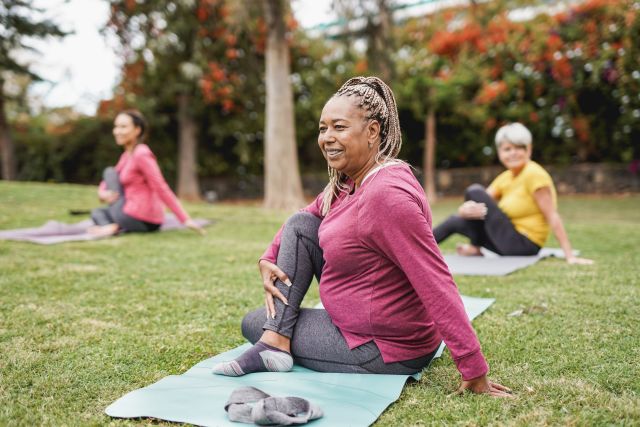Updated on May 23, 2022.
Physical activity is the most effective treatment for fibromyalgia, according to the American College of Rheumatology. Not only can aerobic and muscle-strengthening exercises improve sleep, reduce fatigue, and boost mood—crucially, they alleviate pain.
One of the activities healthcare providers recommend most frequently for pain relief is yoga. Like other workouts, this mind-body practice stimulates the release of endorphins, neurochemicals that act as the body’s natural painkillers.
It’s also a potent stress-reliever. Difficult events in our lives—whether emotional, mental, or physical—cause real physical changes in the body. Among these are changes in blood flow and a release of the stress hormones epinephrine, norepinephrine, and cortisol. Doing yoga, with its breathing, relaxation, and meditation techniques that calm mind and body, reduces the anxiety and tension that cause pain.
Good posture, another aim of the practice of yoga, also can relieve discomfort. Some studies have shown that assuming an expansive, powerful position boosts testosterone, which helps with pain tolerance and decreases cortisol, a stress hormone and pain trigger. Standing tall may also help you feel more powerful and in control of your pain.
Think yoga is too strenuous? Think again. While some types of yoga, such as Bikram, Ashtanga, and Vinyasa may indeed put excess pressure on your musculoskeletal system, there are many types of yoga. Several are especially well-suited for those with health conditions like fibromyalgia.
Here are three types of yoga that are easier on the body and more relaxing than strenuous.
Restorative yoga. In this type of yoga, props like bolsters and blankets are used to support the body and promote surrender into total relaxation. Because of the support, you can hold poses for longer—up to 20 minutes.
The postures are adapted from traditional seated yoga poses but are designed to help relieve the effects of chronic stress. Each sequence is designed to move the spine in all directions to facilitate deep release in connective tissue and calm the nervous system.
"One belief of yoga is that whatever your eyes look at is where you send your energy," says Jessica Klein, a yoga teacher from Montclair, New Jersey. "When you hold poses longer with eyes closed you are more focused on the meditative aspects of yoga and bringing your energy inward." She recommends restorative yoga as a gentle way to try out the practice of yoga if you have never done it before.
Adaptive yoga. If you are a little bit older, unfamiliar with yoga, or have a more significant disability, Klein recommends starting in adaptive yoga. Like restorative yoga, poses are held for long periods of time and there is more focus on breathing and meditation than with traditional yoga. But in this type of yoga poses are modified for those with disabilities or health conditions.
In addition to fibromyalgia, adaptive yoga classes may have students with multiple sclerosis, a sports injury, Parkinson’s disease, stroke, arthritis, or any number of other health conditions. One benefit of adaptive yoga is that several members of the group are usually doing something differently, along with the help of the instructor. In this environment, you may be less likely to feel self-conscious if you can't do something.
Yin yoga. As with restorative and adaptive yoga, yin yoga is a slow-paced practice involving postures that are held for long periods of time. But in Yin Yoga, there is more movement than in adaptive or restorative yoga. "Yin yoga is more suited to younger, more active students who may be familiar with yoga," says Klein.
Yin Yoga poses apply moderate stress to the connective tissue—the tendons, fascia, and ligaments—with the aim of increasing circulation in the joints and improving flexibility. They are also designed to improve the flow of chi, the subtle energy said in Chinese medicine to run through the meridian pathways of the body. Improved flow of chi is hypothesized to improve organ health, immunity, and emotional well-being.







